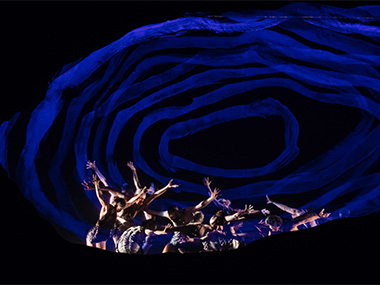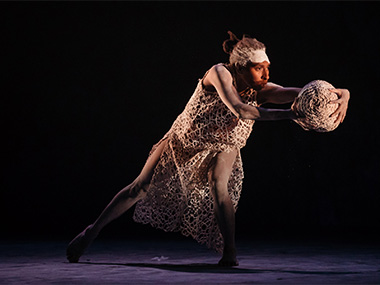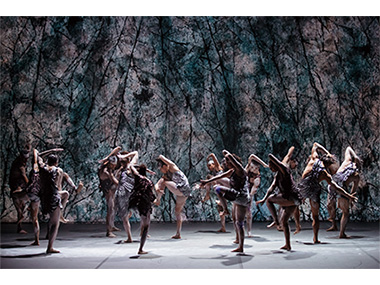DARK EMU

The Bangarra company entwined with Jacob Nash's 3D set taking us up to join the 'Dark Emu' in the sky
Posted by Jeremy Eccles | 15.06.18
Dates:
14.06.18
: 14.07.18
Location: Drama Theatre, Sydney Opera House
Bruce Pascoe's important 2014 book has been turned into performance by the only company that could possibly have attempted it – Bangarra Dance Theatre. In case you haven't caught up with the book (which you really should), The Conversation website has a timely piece by University of WA professor Tony Hughes-D'Aeth in which he lists the recent trilogy of books setting the ecological record straight on Indigenous agricultural capacity, so easily ignored and then trampled over by us white invaders. The others, by the way, are Bill Gammage's 'The Biggest Estate of Earth' and Charles Massey's 'The Call of the Reed Warbler'.
Here's D'Aeth on the Pascoe: “The key contention in Pascoe’s book is that the whole distinction between the farming colonist and the hunter-gatherer indigene is based on a radical, and frankly self-serving, misunderstanding of the way that the Indigenous peoples of Australia lived in their countries. Pascoe assembles a persuasive case that Indigenous Australians farmed their land, lived in villages, built houses, harvested cereals, built complex aquaculture systems — possibly the earliest stone structures in human history — and led the kind of sedentary agricultural lives that were meant only to have arrived with Europeans in 1788”.
And that's the basis for Bangarra's abstruse but evocative stage work, choreographed by Stephen Page with the assistance of two company dancers, Yolande Brown and Daniel Riley. A huge company of 16 tackle the difficult task, as Brown puts it, of “communicating the heart of complex ideas”. Riley adds (in the program), we “use the massed ensembles to convey the spirit of the elements...as opposed to being the elements”.
So don't expect much agricultural reality, despite a program that lists sections such as 'Kangaroo Grass', 'Bogong Moth Harvest' and 'Whales of Fortune'. Indeed, I suggest you forget those titles, and simply sit back and soak up the excellent dance and hope to absorb the emotions that indubitably come off the stage through a combination of dance, music, set fused around the underlying ideas. With the beautiful fire-farming scene, for instance, you almost didn't need the dance – the sound and the visual elements of a huge smoking Banksia cob and showers of sparks rising to threaten the 'Green Poles' backcloth conveyed the story strongly enough. Dancers rising from the foetal position on the floor then evoked the re-birth of Nature.
The same was almost as true of the Bogong Moth story – the sound of fluttering wings over pizzicato strings plus a spiritual Yuin song performed by the late Guboo Ted Thomas evoked the moth's role in South Eastern ceremonial life rather better than the dancers' waving arms. And where was the communal feasting that brought people from the south-eastern coasts up the Bundian Way to the mountains in summer?
Composer Steve Francis has surely emerged from the huge shadow of the dead David Page with Dark Emu's score. His interweaving of more mellow Southern chants than Page's earth-shaking sounds from Yirrkala with electronic and Western instrumental contributions – especially a soulful cello – held the disparate elements together. Bruce Pascoe himself contributed words from his book – though Francis's decision to treat them as part of the score made them less distinct than I'd have liked.
Less effective than this rich score was Alan Valentine's dramaturgy. I guess it's inherently difficult for a monocultural company like Bangarra to identify with the invader; though they did a pretty good job in the more easily dramaturged 'Bennelong'. So, apart, I think, from wearing shorts, it wasn't easy to connect to the dancers 'Crushing by Ignorance' or 'Trampling by Indifference'. And 'Smashing by Colonisation' seemed to consist only of wrapping a group of Sydney people up in a loose rope – nothing like the excesses (on both sides) revealed by historian Stephen Gapps in my recent review of his 'The Sydney Wars'.
Perhaps Stephen Page should consider dancing that book next??
Apart from the backcloth evoking Pollack's 'Blue Poles' given a bushy aesthetic, the show opened and closed with a three-dimensional ovoid that carried the eye up into space where the Dark Emu void between stars represented the cult figure Darumalan for Aborigines across Australia lying on the ground at night. You can see him carved magnificently into sandstone off the America's Track on Sydney's West Head. The sets, made from Jacob Nash's designs, are the work of the team at Scenographic Studio. And a feature of Dark Emu's premiere was a fond farewell to that team which has been creating evocative sets for Bangarra for the 29 years of its life.
While missing on much of the detail in Bruce Pascoe's book, Bangarra's 'Dark Emu' works surprisingly well – exciting a standing ovation on opening night that felt fully justified. Did the Prime Minister rise as well? He was in attendance and, afterwards, Stephen Page claimed he'd attempted to put into the PM's mind the idea that the reality of the Aboriginal inheritance from 60,000 years of ecologically balanced occupation of this land was more important than any romanticised bullshit about the present. Nothing romanticised about rejecting the Uluru Statement from the Heart out of hand, I'd have thought!
After Sydney's performances in the Opera House, 'Dark Emu' tours:
26 — 28 JUL | CANBERRA THEATRE CENTRE
2 — 5 AUG | STATE THEATRE CENTRE OF WA
24 AUG — 1 SEP | QPAC, BRISBANE
6 — 15 SEP | ARTS CENTRE MELBOURNE
URL: https://www.bangarra.com.au/whatson/productions/darkemu-2018
Share this:
»  del.icio.us
»
del.icio.us
»  Digg it
»
Digg it
»  reddit
»
reddit
»  Google
»
Google
»  StumbleUpon
»
StumbleUpon
»  Technorati
»
Technorati
»  Facebook
Facebook
Contact Details

Dancer Yolanda Lowatta thrusts away her Cap of Mourning in a rebirth from the loss of her partner to the colonial intruder

Dancers make hay in front of 'Green Poles', the backdrop evoking a pre-colonial, agriculturally active bush
Further Research
News Tags: Bangarra Dance Theatre | Bruce Pascoe | Dark Emu | Darumalan | Jeremy Eccles | Malcolm Turnbull | Stephen Page
News Categories: Blog | Event | News | Other Event
Exhibition Archive
- 08.06.18 | WARS & MASSACRES
- 03.06.18 | NY “Goes Ballistic” over Aboriginal Art
- 24.05.18 | THE LOCKHART BRAND IS BUOYED UP
- 03.05.18 | THE WYNNE'S A WINNER AGAIN
- 02.05.18 | NATSIAA FINALISTS ANNOUNCED
- 07.04.18 | ENGLAND'S EMILY?
- 04.04.18 | THE SONGKEEPERS
- 19.03.18 | ON GADI COUNTRY
- 16.03.18 | SPECIAL REQUEST
- 20.02.18 | Gapu-Monuk – Saltwater Barks
- 16.02.18 | SONGLINES SYMPOSIUM
- 06.02.18 | SONGLINES – TRACKING THE SEVEN SISTERS
- 31.01.18 | Dennis Nona Emerges in Hobart
- 30.11.17 | Great Artists, Great Stories, Limited Time
- 27.11.17 | Moodoonuthi - 'Little One'
Advertising

